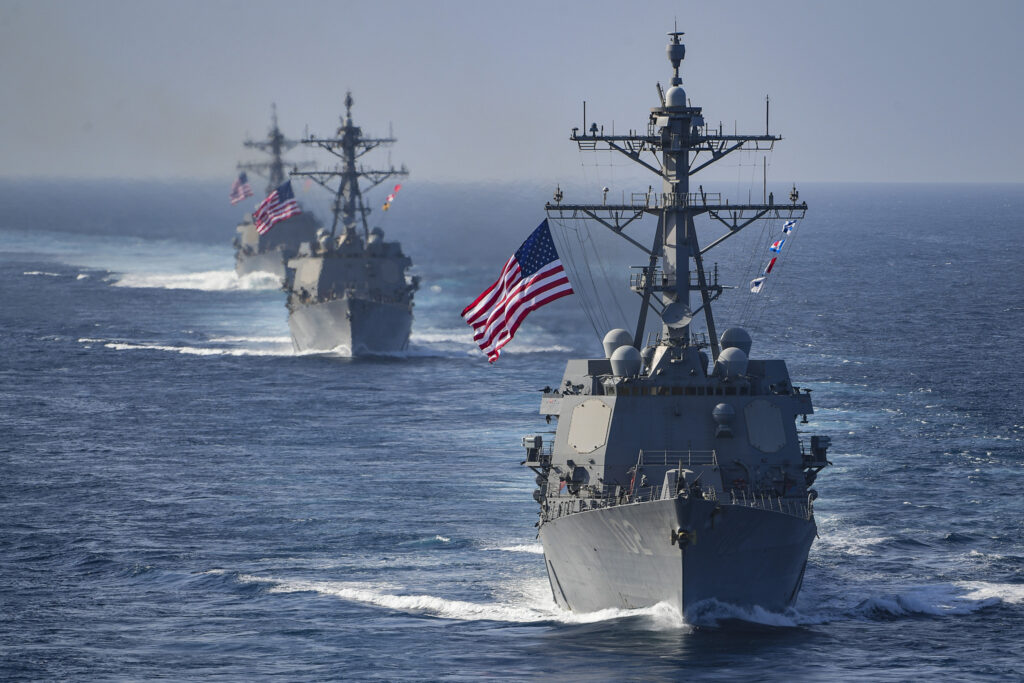
PENTAGON The Navy plans to request a record $205.6 billion topline budget for 2020, money that will be pumped into ramped-up operations, buying new subs, destroyers and aircraft while pushing the fleet above the 300-ship mark for the first time since the early 2000s.
[Click here for all our 2020 budget coverage]
The service’s biggest acquisition program — the $128 billion Columbia-class submarine effort — is also being sped up, with $1.7 billion in funding on the way to a 2021 build date.
The request is the most detailed document we’ve seen to date outlining the Navy’s planned strategic direction in the coming years, offering a picture of a service trying to push into the future of unmanned systems and fifth generation aircraft, while doubling down on large hulls and adding thousands of sailors as the fleet grows.
One of the most significant reveals today was that the Navy plans to reach its goal of 355 ships by 2034, Rear Adm. Randy Crites told reporters here. The Navy’s new force structure plan should be released by the end of the week outlining how it plans to get there, he said.
As we reported, the service will forgo the mid-life refueling of the USS Harry S. Truman aircraft carrier in 2024. The Navy had already spent $538 million on reactor core part in 2008 and 2011 in anticipation of the Truman work, parts that will now be ”placed on the shelf in availability” in case they’re needed in the future for other modernization efforts, Crites said.
It will also fund two new Ford-class carriers, buy an extra Arleigh Burke-class destroyer and a third Virginia-class submarine in 2020. The plan, however, drops to just two Arleigh Burkes a year in 2021 and 2022 compared to the previously planned purchase of three a year.
The request lists $160.8 billion in base funding and a massive $44.8 billion for overseas contingency operations, up from $36.6 billion over last year’s request. The uptick is part of a Pentagon-wide budget gimmick that shifts $164 billion from the base budget to the wartime funding account (OCO) to get around the budget cap placed on the budget by the Budget Control Act.
Capitol Hill is unlikely to approve the OCO move, which will ensure plenty of fireworks this spring and summer.
The budget also calls for $61.1 billion for procurement, $20.4 billion for research and development, and $68.5 billion for operations and maintenance, a 33 percent increase from 2019. The number of ships in the water are slated to increase from 296 to 301 ships.
The Navy is requesting $23.8 billion on shipbuilding and conversion programs, including $22.2 billion to buy 12 new ships.
In addition to the new Virginia subs, Ford-class carriers and destroyers, the Navy is also funding the lead ship in the new guided-missile frigate (FFG(X)) program, slated to cost $1.28 billion.
On the cuts side, in addition to the Truman and the destroyers, the Navy will push two San Antonio-class Flight II landing dock ships, known as LPDs, out past 2024 (the budget equivalent of solitary confinement).
“The hard choices required to achieve this balance include trade-offs in legacy force structure allowing the trade space to accelerate investments in future force capabilities for the future fight,” the service’s budget document said, adding it is “developing and fielding new capabilities in the areas of unmanned vehicles, directed energy, artificial intelligence, hypersonics and other advanced weapons technology.”
The the aircraft budget, the Navy wants to spend $18.6 billion to purchase 148 aircraft, including 20 F-35Cs, which is four more compared to last year’s plan. But it also wants to buy 10 F-35Bs, 10-plane fewer than estimated last year. There is also a line for 24 more F/A-18E-F Super Hornets.
When it comes to the proposed F-35 cuts, those decisions were “tied to force structure mixes,” Crites said, adding that the Navy and Marines are looking to avoid duplicating efforts.
Elsewhere, the Marine Corps F-35B program was slashed by 19 planes over the Future Years Defense Plan (FYDP), with 10 fewer in 2020, five in 2021, three in 2022 and one in 2023.
[Click here for all our 2020 budget coverage]
Major trends and takeaways from the Defense Department’s Unfunded Priority Lists
Mark Cancian and Chris Park of CSIS break down what is in this year’s unfunded priority lists and what they say about the state of the US military.


























